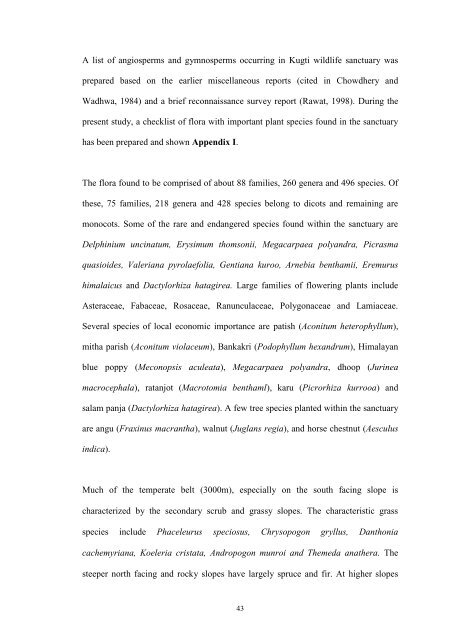Certificate - Etheses - Saurashtra University
Certificate - Etheses - Saurashtra University
Certificate - Etheses - Saurashtra University
You also want an ePaper? Increase the reach of your titles
YUMPU automatically turns print PDFs into web optimized ePapers that Google loves.
A list of angiosperms and gymnosperms occurring in Kugti wildlife sanctuary was<br />
prepared based on the earlier miscellaneous reports (cited in Chowdhery and<br />
Wadhwa, 1984) and a brief reconnaissance survey report (Rawat, 1998). During the<br />
present study, a checklist of flora with important plant species found in the sanctuary<br />
has been prepared and shown Appendix I.<br />
The flora found to be comprised of about 88 families, 260 genera and 496 species. Of<br />
these, 75 families, 218 genera and 428 species belong to dicots and remaining are<br />
monocots. Some of the rare and endangered species found within the sanctuary are<br />
Delphinium uncinatum, Erysimum thomsonii, Megacarpaea polyandra, Picrasma<br />
quasioides, Valeriana pyrolaefolia, Gentiana kuroo, Arnebia benthamii, Eremurus<br />
himalaicus and Dactylorhiza hatagirea. Large families of flowering plants include<br />
Asteraceae, Fabaceae, Rosaceae, Ranunculaceae, Polygonaceae and Lamiaceae.<br />
Several species of local economic importance are patish (Aconitum heterophyllum),<br />
mitha parish (Aconitum violaceum), Bankakri (Podophyllum hexandrum), Himalayan<br />
blue poppy (Meconopsis aculeata), Megacarpaea polyandra, dhoop (Jurinea<br />
macrocephala), ratanjot (Macrotomia benthaml), karu (Picrorhiza kurrooa) and<br />
salam panja (Dactylorhiza hatagirea). A few tree species planted within the sanctuary<br />
are angu (Fraxinus macrantha), walnut (Juglans regia), and horse chestnut (Aesculus<br />
indica).<br />
Much of the temperate belt (3000m), especially on the south facing slope is<br />
characterized by the secondary scrub and grassy slopes. The characteristic grass<br />
species include Phaceleurus speciosus, Chrysopogon gryllus, Danthonia<br />
cachemyriana, Koeleria cristata, Andropogon munroi and Themeda anathera. The<br />
steeper north facing and rocky slopes have largely spruce and fir. At higher slopes<br />
43

















